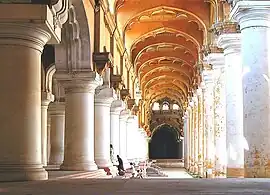| Tirumala Nayaka | |
|---|---|
 A statue of Tirumala Nayaka in Madurai | |
| Nayak of Madurai | |
| Reign | A.D 1623–1659 |
| Predecessor | Muttu Virappa Nayak |
| Successor | Muttu Veerappa Nayak |
| Born | Madurai, Madurai Nayak dynasty (modern day Tamil Nadu, India) |
| Died | c. 1659 Madurai, Madurai Nayak dynasty (modern day Tamil Nadu, India) |
| House | Madurai Nayaks |
| Father | Muttu Krishnappa Nayak |
| Religion | Hinduism[1] |
Tirumala Nayaka (r. 1623–1659) was the ruler of Madurai Nayak Dynasty in the 17th century. He ruled Madurai between A.D 1623 and 1659. His contributions are found in the many splendid buildings and temples of Madurai. His kingdom was under constant threat from the armies of Bijapur Sultanate and the other neighbouring Muslim kingdoms, which he managed to repulse successfully. His territories comprised much of the old Pandya territories which included Coimbatore, Tirunelveli, Madurai districts, Aragalur in southern Tamil Nadu and some territories of the Travancore kingdom.
Tirumala Nayaka was a great patron of art and architecture and the Dravidian architecture evolved into the Madurai style. He rebuilt and renovated a number of old temples of the Pandya period. His palace, known as the Tirumala Nayaka Palace, is a notable architectural masterpiece.
| Kings and Queen Regents of Madurai Nayak Dynasty | |
|---|---|
| Part of History of Tamil Nadu | |
 | |
| Madurai Nayak rulers | |
| Viswanatha Nayak | 1529–1563 |
| Kumara Krishnappa Nayak | 1563–1573 |
| Joint Rulers Group I | 1573–1595 |
| Joint Rulers Group II | 1595–1602 |
| Muttu Krishnappa Nayak | 1602–1609 |
| Muttu Virappa Nayak | 1609–1623 |
| Tirumala Nayak | 1623–1659 |
| Muthu Alakadri Nayak | 1659–1662 |
| Chokkanatha Nayak | 1662–1682 |
| Rangakrishna Muthu Virappa Nayak | 1682–1689 |
| Rani Mangammal‡ | 1689–1704 |
| Vijaya Ranga Chokkanatha Nayak | 1704–1731 |
| Queen Meenakshi‡ | 1731–1736 |
| ‡ Regent Queens | |
| Capitals | |
| Madurai | 1529–1616 |
| Tiruchirapalli | 1616–1634 |
| Madurai | 1634–1665 |
| Tiruchirapalli | 1665–1736 |
| Major forts | |
| Madurai 72 Bastion Fort | |
| Tiruchirapalli Rock Fort | |
| Dindigul Fort | |
| Thirunelvelli Fort | |
| other Military forts | |
| Namakkal Fort | |
| Sankagiri Fort | |
| Attur Fort | |
| Palaces | |
| Thirumalai Nayak Mahal, Madurai | |
| Chokkanatha Nayak Palace a.k.a. Durbar Hall, Tiruchirapalli | |
| Rani Mangammal Tamukkam palace Madurai | |
Tirumala Nayaka's Madurai
_(13936689560).jpg.webp)
Tirumala Nayaka's capital was Madurai. The royal residence had been moved from there to Thiruchirapalli by his predecessor, but Tirumala Nayaka moved it back to Madurai again. The reason for this move is claimed to be due to a dream Tirumala Nayaka had but also stated by historians that Madurai has a long history and continuously civilized through ages and thiruchirapalli is at a threat of immediate attack by Mysore.[2]

Personal life
Ardent devotee
Tirumala Nayaka ate his breakfast only after the pujas were performed at Srivilliputhur Aandal Temple To get the information that the pujas were completed, the king built mandaps about every five kilometres on the route from Madurai to Srivilliputhur and installed loud bells in them. Each mandap also had a small kitchen. When there was a message to be sent a series of bells rang.[3]
References
- ↑ Religion in Vijayanagara Empire, by Konduri Sarojini Devi, p.100 mentions: "Granting that Acyuta conferred on Visvanatha the kingship of the Pandya Mandalam as Father Heras believes, it is possible that Visvanatha changed his faith to Vaishnavism to suit the exigencies. According to the kaifiyat of the Karnata Kotikam Kings, "Acyutadeva Maharaya formally crowned Visvanatha Nayadu of the Garikepati family of the Balija caste as the King of Pandya country yielding a revenue of 2 and 1/2 crores of varahas.
- ↑ "History". Welcome to Madurai. Archived from the original on 16 December 2014. Retrieved 11 November 2014.
- ↑ Kavitha, S. S. (4 July 2012). "You have a message". The Hindu. Archived from the original on 7 May 2023.
External links
- "The Royal patrons of architecture". The Hindu. Archived from the original on 29 June 2004. Retrieved 14 June 2008.
{{cite web}}: CS1 maint: unfit URL (link)
- "Neglect wrecks a Nayak legacy". The Hindu. Archived from the original on 6 June 2011. Retrieved 14 June 2008.
{{cite web}}: CS1 maint: unfit URL (link) - "Festive time at the city of temples". The Hindu. Archived from the original on 17 August 2008. Retrieved 14 June 2008.
{{cite web}}: CS1 maint: unfit URL (link)